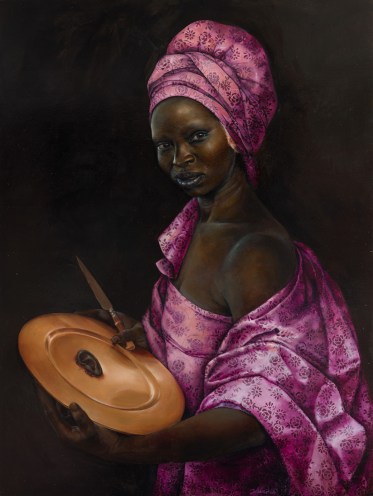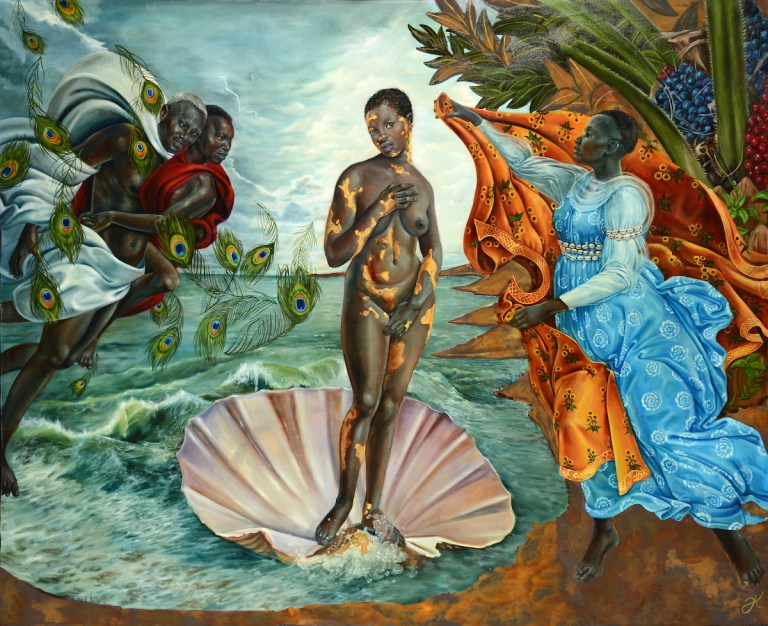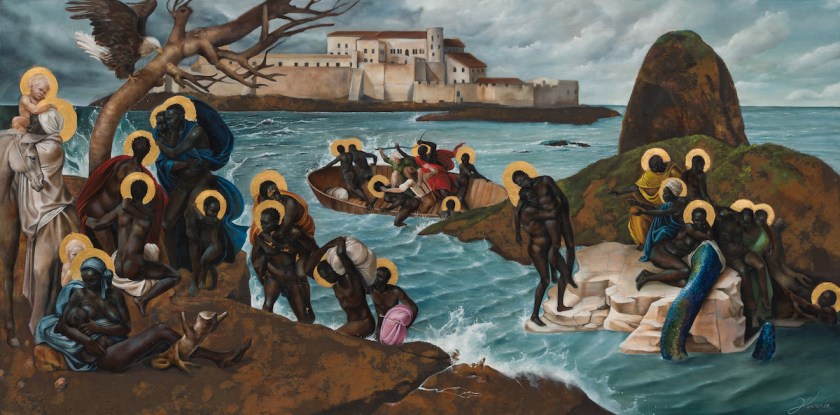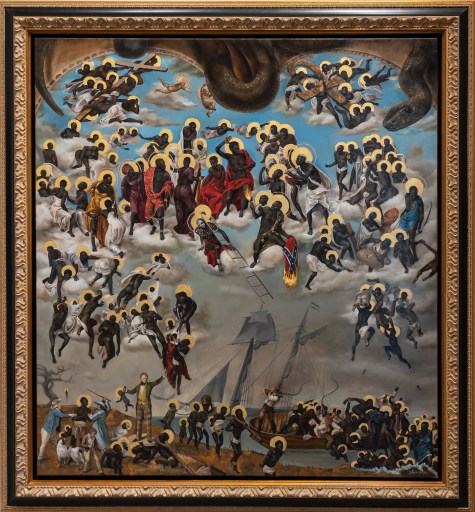African Gods Meet Greek Mythology in Harmonia Rosales’s ‘Entwined’
SoCal-Based Artist Gives Afro-Cuban Orishas the Renaissance Treatment at UC Santa Barbara’s AD&A Museum
By Charles Donelan | April 7, 2022

Upon entering Harmonia Rosales’s show Entwined, on view now through May 1 at UC Santa Barbara’s Art, Design & Architecture Museum (AD&A), one could easily imagine having stumbled into a gallery devoted to the painting of the 15th-century Italian Renaissance. Bright colors abound, figures appear in poses familiar from the art of classical antiquity, and everywhere, there’s evidence of exquisite artistry and technical skill and a passionate, imaginative engagement with mythology.

However, a closer look reveals something profoundly unfamiliar within these works, each of which is so redolent of the art of Michelangelo and Botticelli. These paintings were completed within the past five years, the majority of them as recently as 2021. The many figures that populate them come not from ancient Greece and Rome, or even from Christian iconography, but rather from the mythological/religious pantheon of the orishas, West African deities derived from the Yoruba culture and propagated through the Middle Passage of the Atlantic slave trade into a remarkable diasporic array of circumstances throughout the Caribbean, Brazil, and North and South America.
The artist, Harmonia Rosales, who now lives in Southern California, grew up in Chicago, where she was raised in a family with deep roots in the orisha mythology. Her father immigrated from Havana, Cuba, and her mother was a Jewish Jamaican who grew up in Los Angeles. From her family, Rosales learned the African names of orisha gods — Obatala, Shango, Oshun, Yemaya, and Jeggua, among others — and the oral traditions, the pataki, as they are called. It is “where I come from,” she said. They are the spirits that guided, in particular, her paternal grandmother, and it is these animating principles and compelling narratives that inform her art and worldview. It leads her to say: “It is who I am.”
‘The Birth of Oshun’
Rosales’s exhibition, titled Entwined, calls attention to how African myths may resonate with ancient Greek ones. Her work blends Afro-Cuban orishas with motifs from Renaissance paintings of ancient Greek subjects. For example, in her painting “The Birth of Oshun” (2017), the orisha Oshun occupies a seashell mimicking Sandro Botticelli’s “The Birth of Venus” from ca. 1485. Using symbols — some subtle and some not — Rosales portrays the pataki of Oshun, the orisha who had dared to challenge Olodumare, one of the manifestations of the Yoruba creator god. To storm the heavens, Oshun transformed herself into a peacock, but she was burned by the sun and lost her feathers, inflicting on her skin the condition vitiligo. It’s this alternation between myth and reality, for example, the cunning substitution of a human illness for a legendary feature, that separates Rosales from more orthodox magical realists. It also allows her to avoid the objectification of women’s bodies that pervades Western tradition.
It was how Rosales handled “The Birth of Oshun” that first brought her to the attention of UCSB Professor and Argyropoulos Chair of Hellenic Studies Helen Morales, who curated the Entwined exhibition with Sophia Quach McCabe. For Professor Morales, who studies not only the great works of classical civilization but also their legacy and the vast array of uses to which they are put, it was a revelation. “Classics is sometimes criticized for being too white, Eurocentric, and staid,” Morales told me, “but Classics has a history of including criticisms of itself, and Black and Latinx artists have long engaged with classical antiquity.”

Professor Morales teaches one of the university’s most popular general education courses, a lecture on Greek mythology that routinely enrolls 700 students. This year, as students gradually made their way back to campus after a long, Zoom-based hiatus due to the COVID pandemic, Professor Morales wanted to bring more excitement and glamor to the class by exhibiting a few of Rosales’s paintings. After consulting with Silvia Perea, the former acting director and curator of the museum’s Architecture and Design Collection, and with the assistance of AD&A Director Gabriel Ritter, she expanded the project to include eight images, including several ambitious, large compositions completed during the pandemic in 2021. In this way, the students taking the lecture course became one of the many constituencies served by the exhibition.
“Greek mythology is a discourse of power,” Morales said, “so it can be used to oppress, and it can be used to liberate.”
The appeal of what Harmonia Rosales is doing was that it was not simply an indictment of art history’s exclusions but rather something more creative and expansive. “Her art shows the connection between Greek and African myths,” Morales said.
‘The Migration of the Gods’

One of the most notable recent works in the show is titled “The Migration of the Gods.” It’s a scene of immense scope and pathos, encompassing the Middle Passage and resembling another grand catastrophe, the Great Flood from the Hebrew Bible. Working with her memory of Michelangelo’s treatment of the Great Flood in the Sistine Chapel, Rosales created an image that shows how the orishas of West Africa came to the Caribbean and the Americas with the enslaved Africans who believed in them.
I asked Rosales about this work and her creative process. “When I see images, I interpret,” she said. “Looking at Michelangelo’s The Great Flood, I was like, okay, this will be a perfect image to reimagine because this is about a great force that has happened, and now you see people retreating to the different little lands that are above water. And I thought, well, this image is about survival, right? Catastrophe. And I knew that I could translate or transform that into an image of the Atlantic slave trade. But then I’m always going to think bigger, so I thought, let’s have the gods in there too, because the gods wouldn’t have survived without the people. They wouldn’t be in Cuba and Brazil without the enslaved people and without the way that they kept them secret, by syncretizing them with the Christian saints and so forth. So I thought this was a great way to show that these are the gods who survived through us. It’s the migration of the people, and it’s also the survival of the gods.”
This comment alludes to one of the most intriguing aspects of Santería, or Lucumí, as the New World manifestation of the Yoruba religion is variously referred to, and that is its coded-ness or secrecy. Because enslavers and other White people actively suppressed all African religious practices, demonizing them as “voodoo,” the orishas underwent a process of cultural camouflage. Christian saints became stand-ins for African deities, and spiritual practices hid behind pretexts such as dancing and even, in the case of the Brazilian dance form capoeira, martial arts. It remains possible to discover votive candles in American botanicas depicting masculine images of Santa Barbara that betray how she became fused with the male orisha Shango.
‘Still We Rise’
Another painting from 2021, “Still We Rise,” again engages with the Sistine Chapel by reimagining Michelangelo’s vision of the Last Judgment. In Rosales’s painting, the hell below looks like American slavery, with its slave ships, chains, manacles, and auction blocks. In the strata immediately above, we see Black people engaged in helping each other rise up, using cloth and ladders to climb out of the misery beneath them. On the right-hand side of the painting, ascending figures carry African sculptures aloft, and in the center, a man draped in traditional African cloth burns a Confederate flag. All of the Black figures are haloed in gold leaf, symbolizing the glory of their souls. Finally, at the top, figures cling to a pair of flying crosses as a giant snake, avatar of the sea orisha Yemaya, looks on.

“Still We Rise,” like its inspiration in the Vatican, offers viewers an overwhelming amount of visual information and, in turn, inspires the feelings of awe traditionally associated with the term “sublime.” The picture expresses Rosales’s understanding of Lucumí as both part of the history of the African diaspora and as a way to imagine a Black future.
In discussing the work with Morales, I learned that “Still We Rise” has proved helpful in communicating important threshold concepts in Greek mythology. The idea of a cosmos in which it’s possible to rise and speak with gods but that’s not organized by ethical judgment into a Christian version of heaven and hell is vital in that context as well.
For her part, Rosales believes in using painting to illustrate her historically informed understanding of what it means to rise, to ascend toward a better state of being. In the words of James Baldwin, it’s life as a kind of journey, “a journey toward something I do not understand, which in the going toward, makes me better.” Or, as Rosales told me about her version of heaven, “Heaven is more of keeping up the fight. Not even so much the fight of trying to stay alive as the fight of trying to hold on to one’s identity because they were stripping it from us. And so freedom is knowing who you are, and that’s why I show the gods intertwining in the sky.”
4•1•1
Harmonia Rosales: Entwined is at the UCSB Art, Design & Architecture Museum through May 1. For more information on hours and how to visit, go to museum.ucsb.edu. Follow Harmonia Rosales on Instagram @honeiee.




You must be logged in to post a comment.